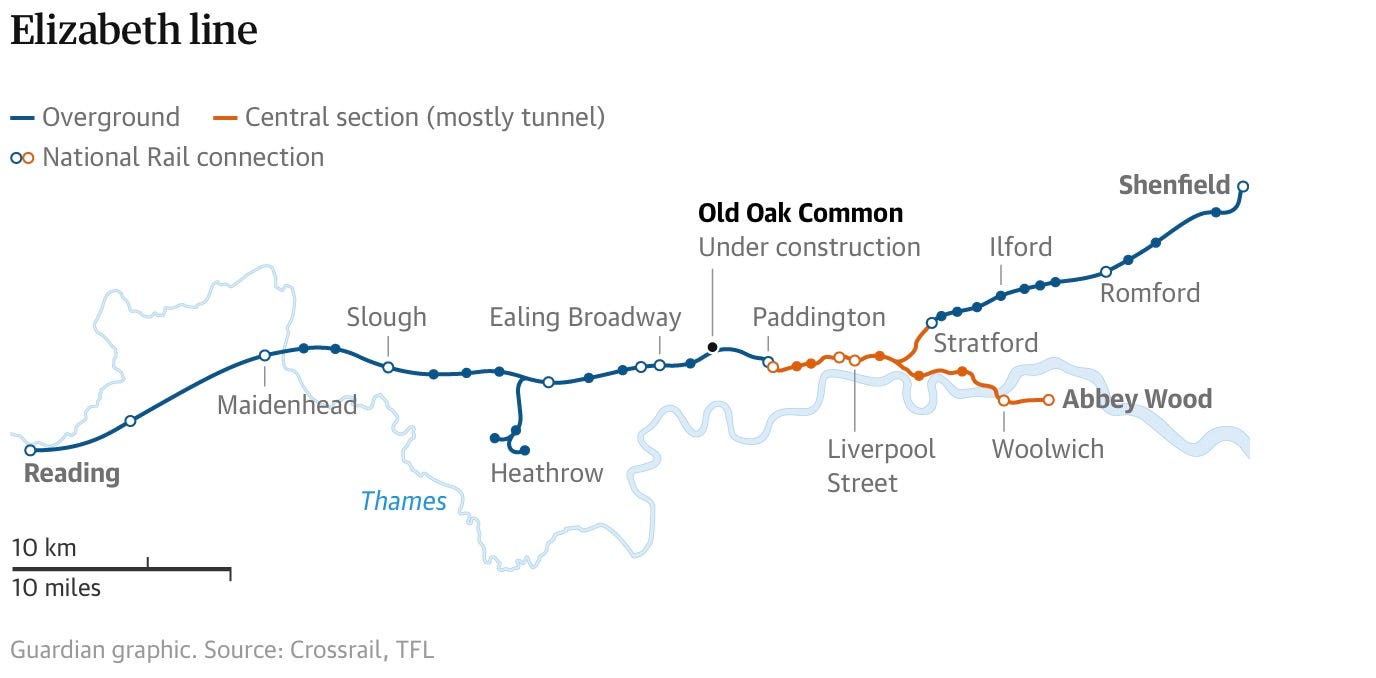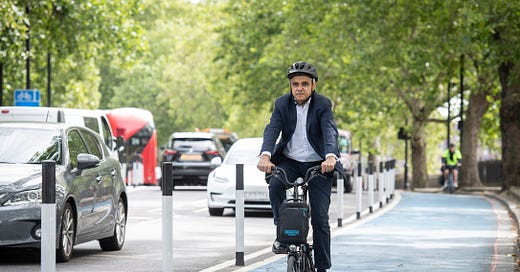Seven years on, London’s sustainable transport goals remain elusive
Key measure in Mayor's Transport Strategy shows no sign of progress - story 64
When he announced his new Transport Strategy (MTS) in 2018, Mayor Khan must have expected some - any progress? - by now on his primary goal. By 2041 he wanted 80% of all journeys made by Londoners to be by active, efficient and sustainable modes. In other words, walking, cycling, or public transport.
The baseline 2018 data for London’s mode share showed 63% sustainable and 37% private motorised transport such as cars, taxis motorcycles.
But seven years into the 25-year plan, that vision has yet to gain meaningful traction.

What is mode share?
The MTS calculated mode share using data collected from
London Travel Demand Surveys (LTDS)
automatic traffic counts
and TfL’s strategic transport models.
LTDS is a diary-based system of randomly selected London residents. Ths is conducted annually.
The automatic traffic counts come from traffic counters on major roads as well as Oyster and contactless payments for bus, tube and rail.
TfL cross check the data against large-scale modelling of travel patterns. It reflects inputs such as population forecast.
TfL view of progress
TfL reported active, efficient, and sustainable mode share for all travel in London in 2023 was 63.2%, up from 62.2% in 2022. Despite this increase, it remained lower than the 2019 pre-pandemic value of 63.6% .
TfL made two interesting points:
it noted that progress on this metric had been hampered by the fact that the overall number of trips being made, including public transport trips, remains below pre-pandemic levels
and they also highlighted that London's slower than expected population growth is a contributing factor
Whatever the factors, the level of sustainable travel seems stuck. In 2015 63.2% of all trips were made using walking, cycling or public transport. In 2023 it was still 63.2%.
That is why the Healthy Streets Scorecard assessment in July, 2024 said the sustainable mode share was
Below the trajectory needed to meet the 2041 target and well below the trajectory needed if brought forward to 2030 to support the net zero pathway.
Reasons to worry
Much of the pessimism around these numbers is because of what has happened since 2018. London has undergone several major shifts in that period that could have accelerated progress toward sustainable mobility.
The Pandemic
Covid changed how we lived including travel but many of those changes did not persist.
Take cycling - one of the three parts of the sustainable transport ambition. The big expansion of the strategic cycle network from 90 km in 2016 to over 400 km by 2024 has made cycling more accessible. And there are more cylists. Cycling mode share went increased during the Pandemic.
But then cycling’s mode share fell away again before starting to recover to 4.6% in 2024.
Similarly, those working from home increased from 5% in 2019 over to 50% a year later. Last year, about a quarter were hybrid workers and only 14% remained from home.
Hopes of a transport silver lining to the pandemic may have been misplaced.
Crossrail or Elizabeth Line
This has been hugely succcessful. It is the twenty first century poster child for sustainable public transport.

As the Guardian summarises
Halfway to a billion journeys, and it’s only just begun.
Now accounting for one in seven national rail journeys, the east-west cross-London railway has smashed forecasts and remoulded the travel habits and urban geography of the south-east.
In February 2025
.. the Elizabeth line reached a milestone of 500 million passengers since it opened in May 2022. That figure has all but restored rail’s official passenger numbers to pre-Covid levels, fuelling the belief of those in the industry who forecast usage would boom again.
And yet .. there are no other comparable transport projects in the pipeline. Even the supporters of the Lower Thames Crossing would not position this as promoting sustainable travel.
ULEZ
The same can be said for the Ultra Low Emission Zone. In August 2023, London's mayor, Sir Sadiq Khan extended the zone which aims to cut pollution to outer London. And ULEZ is working - pollution in London has been reduced.
There was a chance that as older vehicles were withdrawn from the domestic and commercial fleet, some might not be replaced on a like for like basis with newer models. There is no data suggests this happened.
Again, a major initiative which might have yielded results which did not.
Cost of living
This is a temporary factor that could have been expected to provide a temporary boost to sustainable travel. It is cheaper to catch the tube, train or bus to get around London in many cases.
Sustained double-digit inflation might have encouraged some to forgo buying or using their cars as the price of fuel and parking fees increased.
The data suggests something different is happening: instead of fueling public transit use, it has prompted many residents to cut back on travel altogether.
To manage living costs, 47 per cent of London residents report to be spending less on non-essentials, and 29 per cent report using ‘free transport (walking or cycling)’.
.. Residents were making 11 per cent fewer trips for leisure purposes and eight per cent fewer trips for shopping and personal business compared to the previous year.
Four significant events, then - two temporary and two permanent - which could have changed how London moves, but indications so far suggest habits are remarkably resistant to change.
Notes & thoughts
Changing the mode share lies at the heart of improving how Londoners live and travel. The ambitions of the Mayor’s Transport Strategy remain relevant. More so.
We are seven years into a 25-year strategy - nearly a third of the way through.
The Mayor recognised in 2022 with the MTS amendment that progress was too slow and so accelerated the target for reducing trip miles by 2031. He - we - are some way off that target too.
TfL is right to call this a ‘decisive decade’. Londoners need the Mayor and the General Assembly to support significant opportunities to accelerate progress on improving the mode share.
A dedicated walkers, wheelers and cyclist bridge over the Thames is a positive contribution in that process for this corner of London. Restoring cars not only discourages cycling in the city, it positively encourages more private cars
Three other thoughts.
There is a clear difference between mode share for inner and outer London. I will cover this in a separate post. Barnes and Mortlake as part of Richmond Borough are both in outer London.
Looking further ahead there are some positive indications about the preferred behaviour of younger Londoners, those aged between 18 and 35. The results are only affecting car ownership currently but there is a good chance they start to feed through during the next ten years. Again, more on this later.
Finally, there is a sense in the data that the 2024 performance will give a better idea of how post-Covid London is settling down. Could the bikes, buses, tubes and trains numbers edge up beyond their 2019 equivalent?




